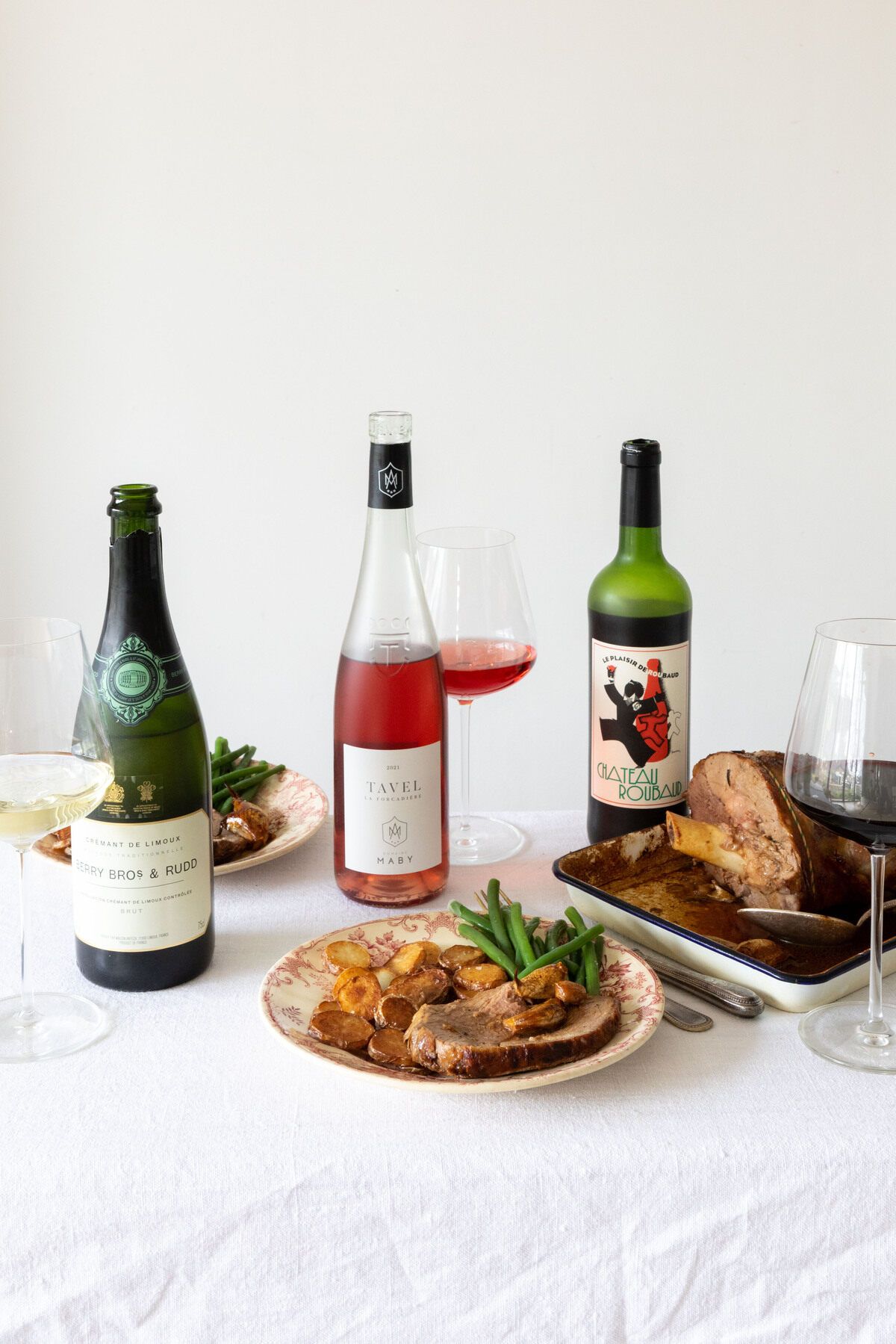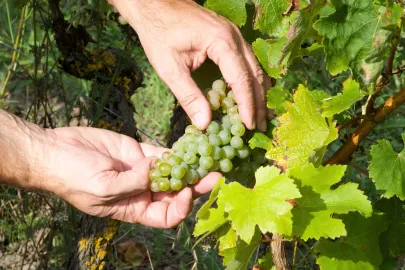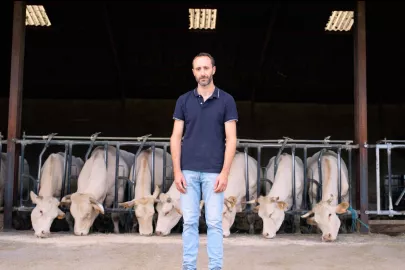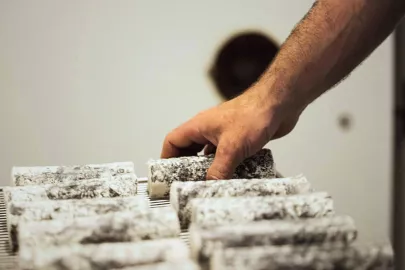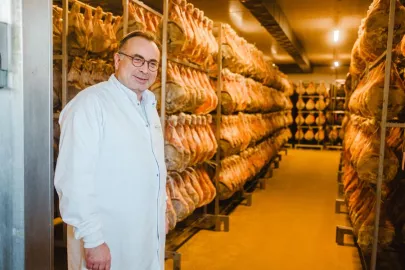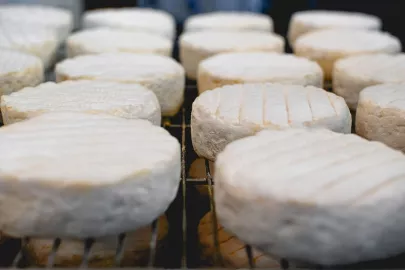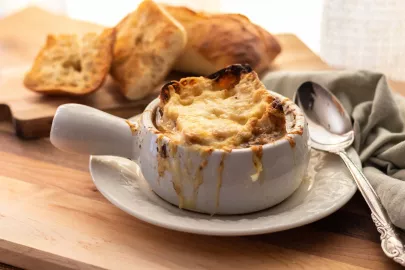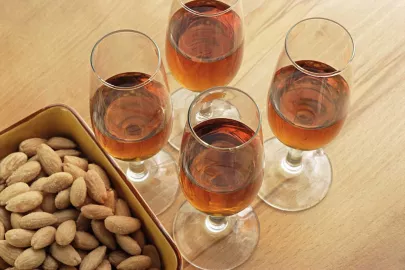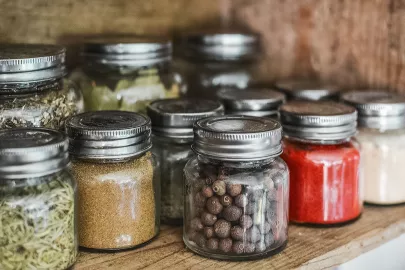Read on for a report that follows in the footsteps of an exceptional, protected, and certified lamb from sheep fields to gourmet restaurants.

One is the head of his flock, while the other oversees his kitchen staff. Still, Provence natives Guillaume and Jany promote the Sisteron lamb each in their own unique way. On the city's hillsides, the shepherd carefully looks after these special lambs, which are used to produce snow-white wool and a tender, pink meat. Down in the valley, the Michelin-starred chef works to enhance the aromas of a meat that is famous for its refinement and tender texture.
In a symphony of minor-tuned bells, 820 white heads look up simultaneously in a "tangle" of suspicion and curiosity, according to the vocabulary common to the part of Provence we are exploring for the day. To reach Guillaume Garcin's farm, we drive through Sisteron, which is overlooked by a proud citadel perched atop a craggy peak, and wind our way through Fontbelle Pass, whose hairpin turns are a challenge for anyone without an ironclad stomach. On this early June morning, the air is already warm and redolent with the impatience of the sheep, who defiantly watch as a stranger dares to step foot on their territory, doubtless suspecting she is the reason why they are still in their meadow at this odd hour. The shepherd confirms my suspicion, "We were waiting for you to leave." Straw hat pulled low over a tanned face set off by strikingly blue eyes and walking stick firmly in hand, Marie, equal parts amused and bemused, listens to us gush about the blue sky, green grass, and endless Provence horizon, which rings with the chirps and calls of insects, just like the books say.

© ©Cyril Entzmann Divergence
Sheep or lamb?
"Hello, and welcome to my home." Guillaume's arrival and warm welcome further confuses the flock. Complete with a sing-song accent, this Provence-style Goliath seems to embody the power of the cold mistral wind, hot summer, and rocky soil. Guillaume offers a firm handshake and kind smile. It's clear this giant of a man lives and breathes his animals. What can a shepherd and a city girl talk about, you might ask? For starters, the difference between a sheep and a lamb. The first is an adult female sheep, while the second is a sheep who is less than one year old. For Guillaume, taking over the family farm was never a question. "I could never imagine myself doing anything else or living anywhere else," says the thirty-something shepherd as he gestures to the Durance Valley and the long line of mountains on the horizon. It is truly an impressive sight to watch him walk out in the middle of his Préalpes du Sud sheep, give the cue to leave in a language that only they understand, and see the white and noisy woolly wave rise up and begin to move. A head emerges from the surface from time to time like foam on a choppy sea. A red or blue dot can also be seen from time to time. "Those marks are for the ewes that are expecting one or two lambs," Guillaume explains. The process is far from chaotic, however. Three large Anatolian shepherd dogs and several Rove goats, complete with a majestic set of horns, are busy collecting any lost or overly adventurous lambs. The sheep crowd around the gate, and for good reason—they know they're off to fresh pasture, with new thickets to explore, bushes to eat, and green grass to enjoy.

© ©Cyril Entzmann Divergence
Nomadic pastoralism and natural nursing
Tonight, the flock will have to go back to the sheep pen. In a few days, however, the ladies will be able to enjoy this land of plenty that is the Provence mountainside until August. The sheep will be able to spend a peaceful summer of wandering and resting. As long as the wolves don't bother them, that is. Since July 14, 2010, nights in the mountain pastures have become decidedly less calm. The flock is constantly on alert when danger, in the form of a large skull, broad forehead, long muzzle, and razor-sharp jaws, is on the prowl. One night, Guillaume was sleeping with his flock when he locked eyes with a hunting wolf. He said its eye "cut him to his core." His voice and his dreams are still troubled by the memory of his close encounter, in which nobody walked away a winner. As if to banish these dark memories, Guillaume starts to talk about the upcoming season's new lambs. Starting in late August, the entire family will take turns watching over the sheep to help them give birth and make sure the newborn lambs are able to find their mother's udder, where they will spend the first two months of their lives. These lambs, which are raised using nomadic pastoral methods, born in Provence, and allowed to nurse naturally, receive Protected Geographic Indication and Label Rouge certification. Decorated with these distinctions, they head out towards the horizon. To wrap up our interview, Guillaume offers to show us one of the alfalfa fields he has planted to feed his sheep. "I rake the hay into windrows," he tries to explain to the wayward student that I was. I am less impressed by the careful arrangement of the drying hay than I am with the chance to take a ride in the tractor.

© ©Cyril Entzmann Divergence
Butter or olive oil?
We wind our way down to the valley in Château-Arnoux to visit the stomping grounds of chef Jany Gleize. His restaurant, called La Bonne Etape, is another self-evident choice steeped in a family history and passed down by the generations that came before. It all started when a car broke down at this very site. The man who would eventually become the chef's father was behind the wheel. His future mother was standing in front of the building. As a child, Gleize grew up in a kitchen. Nevertheless, he refused to eat anything other than meat broth and carrots. He discovered his love of food at the age of 12, when his father made him hare "à la royale," an iconic French dish. His taste for fine dining brought the young Gleize to the principal's office, where he complained about the career counselor's choices. The connoisseur later decided to trade in his kid's shorts for an apron and a chef's hat. After receiving training from top-shelf cooks, the enterprising chef returned to his family home, which straddles the dividing line between two culinary traditions in France. "Sisteron is at the border between northern and southern France. Since the end of the 19th century, it has been the gateway between two civilizations, with cream and butter on one side and olive oil on the other."
As I follow the chef through his restaurant, I mentally apologize for wearing the same sneakers I wore in the sheep pen. The dining room's soft red carpet, thick drapes bordering the windows, and crown molding cut a solemn figure. On the tables, spotless faience plates flanked by silver cutlery quietly await the arrival of the evening's guests.
Cook, then let rest
In the kitchens, we are welcomed by a rare silence. Since the coronavirus lockdown, the pots and pans have been sitting unused on the shelves. The sound of knife sharpening soon overtakes the low buzz of the refrigerators. The chef is preparing his weapons. Two scarlet tomatoes are chopped between his expert hands. A pair of plump organic bell peppers are added to the skillet, followed quickly by slices of juicy eggplant and crisp zucchini. A crackling layer of olive oil starts to brown the vegetables. Now that the background music is established, it's time for the star of the show.
Sisteron lamb is pink, tender, and ringed with a layer of fat earned from hours spent nursing. Its qualities and flavors speak for themselves. Jany uses his knife to expertly open the lamb, remove the skin, and cut out a fillet. In the skillet, the vegetables sizzle with the arrival of a slice of lamb. The meat starts to cook, releasing a complex array of fragrances. Suddenly, everything goes quiet. Is it already done cooking? "The cooking time is just as important as the amount of time you let the meat rest," explains the chef. To distract our senses, Jeanne, who has just started working in the kitchens with her father, prepares the plates. With slender tongs, she arranges the vegetables and makes a beautiful and balanced presentation in just a few minutes. The lamb is placed in the middle of this colorful and precisely constructed throne.
We walk to the restaurant's dining area with all the solemnity of a religious procession. We gather round a table in silent homage to enjoy a type of lamb that we knew nothing about that very morning. A bit shyly, I take the silverware Jany gives me. The flavor and tender texture of the Sisteron lamb explodes across my palate.

© ©Cyril Entzmann Divergence

© ©Cyril Entzmann Divergence
Contributor
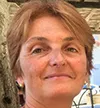
Editor


